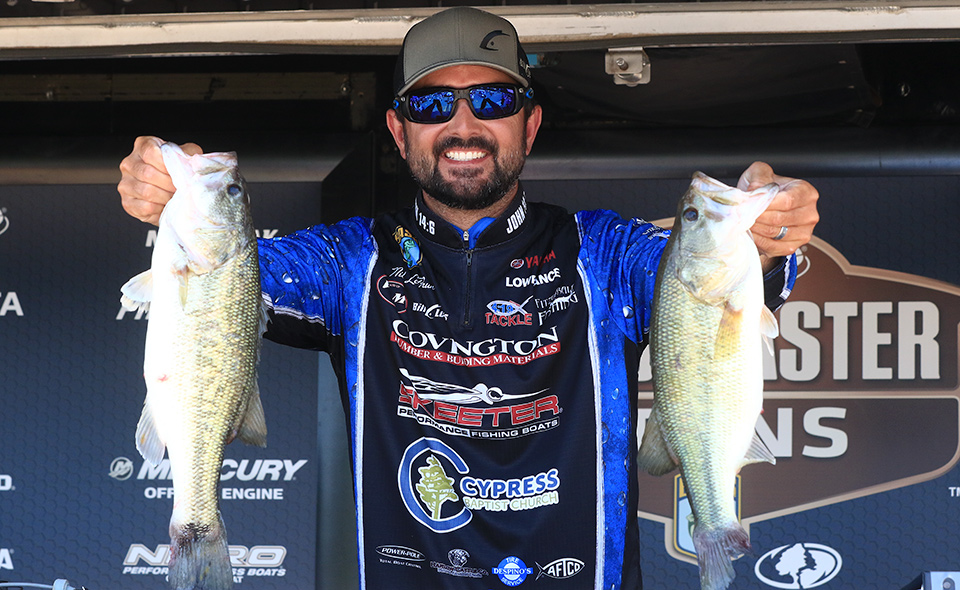
At Friday’s weigh-in, Nick LeBrun said he was excited to fish on Championship Saturday. Of course, making the top-10 cut is always a big deal, but the pro from Bossier City, La., who placed second on Day 2 was particularly eager to expand on what he believes could be a winning pattern.
“I think I have some fish coming to me,” LeBrun said. “I think I found a late wave of spawners. I’m not sure, but the way they’re hitting and the way they’re fighting, I think they’re spawning.
“There is definitely one little key for spawners; it is bank-related. It’s a certain kind of structure and it takes the right kind of angle to get the fish to bite. Sometimes it takes multiple casts, but you have to throw in there like (you know) one’s sitting there and just force him to bite.”
LeBrun got off to a strong final-round start, as he recorded the day’s first limit and showed a total of 13-11 at 10:30. He entered Day 3 trailing Day-2 leader, Bassmaster Elite Lee Livesay by 3-4, but has held the top spot most of the morning. (Weights unofficial until weigh-ins.)
Elsewhere, Lee Livesay placed second on Day 1 by catching a limit of 25-12 from a specific point on a drain running through a flat adjacent to likely spawning areas. On Day 2, he found his area lean on the opportunity and caught only four of his keepers in a small limit of 10-4.
Noting that he was able to fish exactly where/how he did a day earlier, Livesay surmised that some of the fish in his area may have moved to the bank. After catching his weight, he stopped fishing at 9:08, so it’s unlikely he completely exhausted the spot.
In the latter part of Day 2, after watching a couple of competitors catching fish on the bank, Livesay moved shallow and caught a fish on a frog. Whether or not that fish was on or near a bed is unclear, but frogging is definitely a good way to catch them in that stage.
So, will Championship Saturday see enough of a spawning movement for anglers to score big? Today’s warm, sunny conditions will certainly help. A cloudy, breezy morning yielded to clear skies, so as the day warms, good things may start to happen.
Ross Barnett holds a big population of stocked Florida-strain largemouth, which typically like to make their big moves in the afternoon. After several hours of solar heating, the bedding zone reaches the cozy temperature these fish favor, so this could become a factor today.
The challenging part is Ross Barnett’s low visibility. Water clarity, or the lack thereof, won’t stop fish from spawning, but it obviously limits an angler’s ability to see. Even with sunny skies, traditional “sight fishing” is not likely to play a role in any spawning activity that may occur.
The most practical technique will be what LeBrun described as “chucking and winding” — throwing moving baits that allow the angler to cover a lot of water and locate active fish. Once bass move into spawning locations, they become highly territorial and protective against nest-raiding bluegill.
Making rapid casts with swim jigs, bladed jigs, swimbaits, swimming worms, frogs or buzz toads allows you to probe promising areas to entice a bite, or spur a fish to reveal its position. Boils, wakes, swirls — all clearly indicate a fish with the “No soliciting” sign on its front door.
Targeting that are with repetitive casts, or flipping jigs or Texas-rigged plastics to the red zone often closes the deal.
If LeBrun can steadily build on his early success and find a big kicker, he’ll add another Bassmaster Opens trophy to the one he claimed at last year’s Central Open at Grand Lake. However, if any of his competitors lands on the right spot when a bunch or fish move up — or if they locate a pile of postspawners eager to eat — we could see afternoon fireworks.





